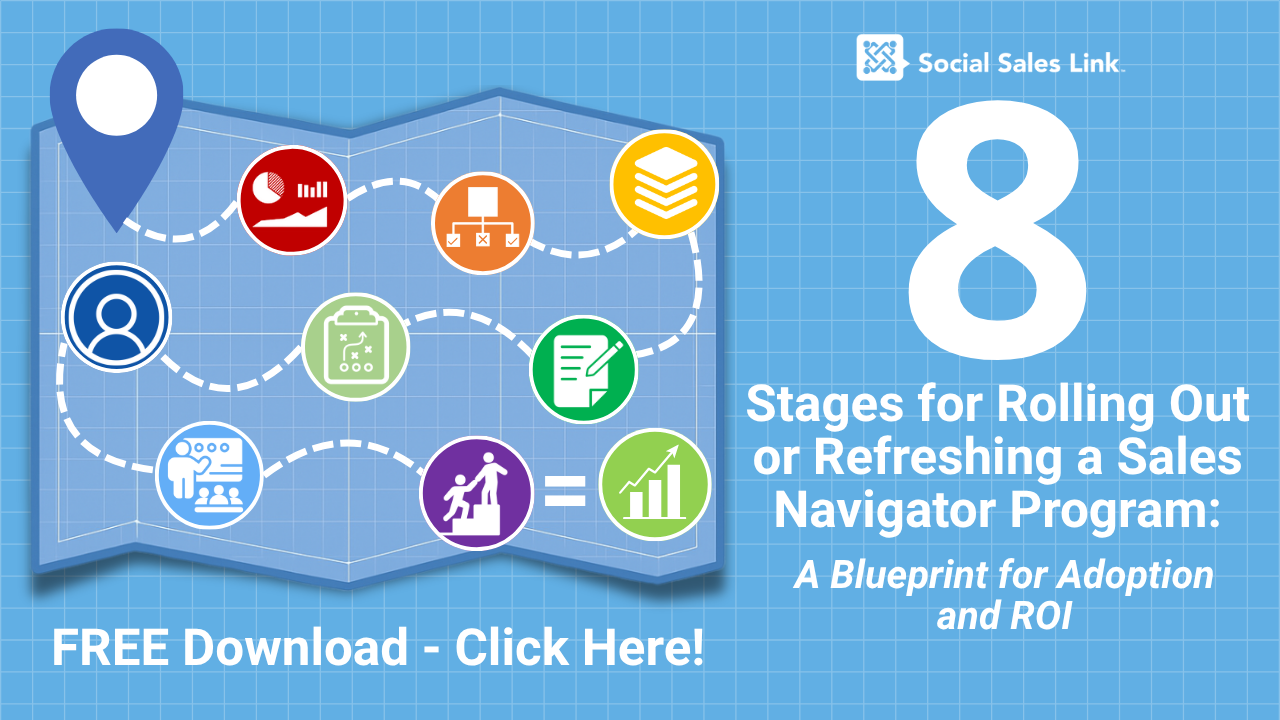Embedding LinkedIn's Sales Navigator Into Your Team's Workflow
It’s not about just “using” Sales Navigator.
The TL;DR (Executive Summary)
Sales Navigator success isn’t measured by logins. It’s measured by behaviors.
Embedding Sales Navigator into your workflow means making it a part of every sales motion, not a “bonus activity.”
Leadership sets the tone: When managers coach from insights surfaced by Sales Navigator, teams will naturally follow.
The goal is to make deep sales a daily rhythm… where context, connection, and consistency drive every interaction.
When Sales Navigator becomes muscle memory, the tool disappears, and better selling just happens.
The 90-Day Problem
Every sales leader has seen it: licenses get distributed, excitement spikes, and usage climbs for about 90 days.
Then, it flatlines.
Not because the tool doesn’t work, but because the workflow doesn’t change. Salespeople revert to what’s familiar (email lists, CRMs, “just checking in” calls [ugh]), while Sales Navigator sits idle like an unused gym membership… or that language app you open once a quarter to remind yourself you’re ‘learning Spanish.’
The truth? Adoption doesn’t come from distribution. It comes from integration.
And integration doesn’t happen in a training session. It happens in the daily rhythm of selling.
From Tool to Tempo: Making Sales Navigator a Habit
Sales Navigator shouldn’t live in isolation. It should live inside your existing workflow… CRM, meetings, 1:1s, pipeline reviews, and even prospecting routines.
Here’s what that looks like:
Start Every Day Inside Sales Navigator
The best reps don’t check email first. They check insights.
Who changed jobs?
Which accounts are showing intent?
What new connections have surfaced through TeamLink?
When Sales Navigator drives your morning priorities, the rest of the day gets smarter.
Run Pipeline Reviews Through a Sales Navigator Lens
During pipeline meetings, don’t just talk about stages and next steps. Ask:
“What did Sales Navigator tell you about this account’s recent moves?”
“Who else inside that company could open a door?”
“What insights can we use to re-engage stalled opportunities?”
This shifts Sales Navigator from a tool to a trusted source.
Align CRM Notes With Sales Navigator Insights
Sales Navigator is where insights start. CRM is where deals live. Encourage reps to bring their Sales Navigator discoveries into CRM, like job changes, company updates, and connections… so intelligence flows both ways.
Make Sales Navigator a Standing Agenda Item
Whether it’s weekly sales calls or monthly coaching sessions, review what’s being learned and applied from Sales Navigator.
Who booked a meeting because of an alert?
Which connection led to a warm introduction?
How did Account IQ influence your outreach?
Celebrate these stories. They make Sales Navigator real.
When Leadership Leads With Insight
Adoption follows example. If sales leaders don’t use Sales Navigator themselves, teams never will. Period.
The moment leadership starts showing Sales Navigator data in meetings, referencing signals in strategy sessions, and acknowledging wins driven by deep sales behavior, the shift begins.
Try this: Instead of asking, “Did you use Sales Navigator this week?” ask,
“What did Sales Navigator teach you about your top five accounts this week?”
That first question frames usage as compliance. The second one reframes it as learning.
The Rhythm of Deep Sales
Embedding Sales Navigator isn’t about logging in more often. It’s about changing how sales teams see their work.
In a deep sales rhythm:
Prospecting becomes proactive, not reactive.
Outreach becomes contextual, not scripted.
Conversations start from insight, not interruption.
Sales Navigator becomes the drumbeat. Every signal, every alert, every insight keeps the team moving in tempo with their buyers.
That’s when deep sales stops being a platform… and starts being a culture.
Could This Be You? Turning Adoption Into Advantage
Let’s say you have 50 Sales Navigator licenses for your team. You discover that after the initial rollout, fewer than half of your team members were logging in weekly.
(That happens. A lot.)
So you decide to shift the approach by:
Opening team meetings with “Top 3 Insights from Sales Navigator.”
Recognizing Sales Navigator-driven wins during team meetings and as they happen… in real time.
Having reps share their screens during manager 1:1s to walk through saved searches and alerts.
I can guarantee that two months later, you’ll see usage double. Within three months, your team’s meeting-booked rate will jump… perhaps by as much as 40%.
The tool itself won’t change. The tempo will. And you will see results.
Leadership’s North Star: Coach Curiosity
Great leaders don’t coach on tools; they coach on thinking.
When you lead teams to be curious -- to seek understanding before pitching -- you’re building a deep sales culture that outlasts any platform.
And when Sales Navigator becomes the bridge between curiosity and connection, selling feels less like selling… and more like helping.
That’s the point.
Wrapping It Up
Sales Navigator adoption isn’t about compliance. It’s about cadence. When leaders model curiosity, teams follow. When Sales Navigator becomes part of the workflow, adoption takes care of itself.
And when adoption sticks, deep sales becomes second nature.
Because the ultimate measure of success isn’t how often your team logs in. It’s how naturally they think, act, and connect. Like humans, powered by insight.
A Look Ahead
This is Part 4 of my series Making Sales Navigator Work: From License to Lifeblood. So far, we’ve covered:
Part 1 - Why LinkedIn’s Sales Navigator Fails (and How Leaders Can Fix It)
Part 2 - The ROI of Consistency: It’s Sales Navigator, Plus...
Part 3 - How LinkedIn’s Sales Navigator Helps You Sell Like a Human
And coming next week:
Part 5 – The New Sales Operating System: Leading a Deep Sales Culture
We’ll explore how to turn these habits into a company-wide operating system… where sales, marketing, and leadership align around shared insight, consistent language, and a truly buyer-centric approach.
In the meantime, what do you think? Do you agree that embedding Sales Navigator into your team’s workflow means making it a part of every sales motion, not a “bonus activity?” And do you think that you, as a sales leader, should be “in” Sales Navigator every day? Any other thoughts? Let me know in the Comments section below.
NOTE: The hero image for this article was generated by AI, with no notes from me after its first try.
If you want Sales Navigator adoption that sticks, you need a rhythm… not a reminder.
The 8 Stages for Rolling Out a Sales Navigator Program shows you how to weave Sales Navigator into the workflow so deeply, it becomes second nature.
Download our free eBook and start building that rhythm today.




Wow, the part about the 90-day problem really stood out; thank you for emphasizing that integration, not just distribution, is crucial for sustained sucess.